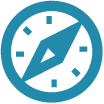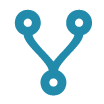
A user-friendy conceptual model for a cognitive automation platform.
 I led the project to make the Workfusion platform easier to learn and more efficient to use more
I led the project to make the Workfusion platform easier to learn and more efficient to use more My research identified a major pain point - users had difficulty understanding the relationships between the platform's features more
My research identified a major pain point - users had difficulty understanding the relationships between the platform's features more I designed a new conceptual model that introduced key experience principles into the platform's user flows more
I designed a new conceptual model that introduced key experience principles into the platform's user flows more After getting buy-in from stakeholders, I developed a road-map for gradually rolling out and validating the design more
After getting buy-in from stakeholders, I developed a road-map for gradually rolling out and validating the design more

Context
When Workfusion began operating, it relied largely on internal developers to tweak its software for each client's specific use case. Over time, these custom tweaks were incorporated into the software as standard features for business users. However, business users found these features difficult to understand, requiring substantial amounts of training.
Workfusion's senior decision-makers saw that this would threaten the company's ability to scale, and sought to improve the user experience. I was hired to be responsible for user research and UX design within the company – to understand this situation, find a way to resolve it, and make sure that future development aligned with user-friendly principles.
My roles
- Customer insight & ideation – I partnered with a business analyst and a training specialist to understand how users were currently learning and using the Workfusion platform, and what the biggest pain points were.
- Experience strategy & vision – Through user research, I established a more effective conceptual model out of the concepts involved in Workfusion. I led meetings to share this vision, gain alignment with my team, and get buy-in from decisionmakers.
- Planning & scope definition – I worked together with a product manager to define the total scope of the changes, and develop a roadmap that would gradually implement my vision.
- Design execution & validation – Based on the new information architecture, I created scenarios, wireframes, mockups, and prototypes.
Discovery
As an automation startup, Workfusion's value proposition depended on new concepts that would not appear in any existing software familiar to business users. I sought out Marketing and Pre-Sales stakeholders, to understand what concepts potential users found easy to understand, and what concepts were challenging for us to get across in our product demos. This quick investigation formed the foundation for my further research by helping me understand the context from which our users' mental models would develop.
I started by investigating how current users developed their understanding of the system. I ran think-aloud tests with novice users to gauge their understanding of key flows, and surveyed them about which aspects of the system they found most difficult to understand. I also joined training and support calls to see what issues customers were having with learning and using the platform (and by extension, what frustrated our Customer Success team). To aid with data collection, I created an internal resource where the CS team could record breakdowns in the platform's user experience. I also gave a brief presentation on user experience research within the company to increase the quality of the data recorded in this resource. After collecting the above information, I worked with the CS and development teams to create a cost-benefit analysis of the issues I discovered.
It was at this point that I found it difficult to get buy-in from stakeholders in development. They were certain that new users were not representative of the user base Workfusion would someday have, and that design efforts should focus on making the experts more efficient. While I disagreed, I was willing to perform my tests on the expert users as a compromise. In addition to helping the experts, I had two goals in mind. The first was to understand the path that expert users took in learning the platform, and how to help novices reach that point faster. The second goal was to find the work-arounds that experts used, and formalize them as explicit parts of the workflow that novices could easily discover and use. To that end, I performed contextual inquiries with the experts, to understand their daily use.
Ultimately, I discovered that few expert users were true adaptive experts, but rather became routine experts through repetition of a small number of workflows. It was difficult for novice users to even get to this point, because key parts of the system had been developed independently and the user flows that led through them were not apparent. Even users who had been with the company for years had limited understanding of the system's structure. I presented this research to developer stakeholders, and was able to get their buy-in for a redesign of the necessary magnitude.
Design Process
I established two key design principles that the redesign would follow, taking into account the results of my research as well as the needs of stakeholders within the company. Firstly, the system had to establish clear user flows to its users on the principle of recognition over recall. A user should never need to remember where to go next – all interactions would be self-evident. This emphasis on clear flows gained support from the Sales team, as it would lead to streamlined and impressive demos for prospective customers. Secondly, the system's conceptual model should be logically thought out and clearly presented to the user. The many disparate threads and features added to Workfusion over five years of development would be brought together into one coherent whole. This was a very attractive change for the Customer Success and Training teams, as it would greatly simplify the onboarding of new users.
I began the design process with a series of participatory design sessions, involving members of the CS team. I introduced the key concepts of the new system to them, and asked them to walk me through an abstracted version of the typical user flows using these concepts instead of the current UI. This exercise allowed us to validate our new conceptual model, and develop a more detailed list of ways that users expected the components of the system to interact. I used this information to develop an information architecture map for the redesigned application, and then created wireframes for paper prototyping. I gradually developed the wireframes into high-fidelity mockups, and then into clickable Mockplus prototypes.
I presented these prototypes in regular meetings with senior stakeholders, to get feedback and buy-in. Whenever anyone disagreed about the value of some changes, I worked with them to understand why, and presented qualitative data (survey results) and quantitative data (user testing results) to back up my vision. Whenever we lacked the development resources to implement a component of the design, I would meet with developers and stakeholders, and find a compromise that still accomplished our goals while limiting the amount of effort necessary to build it.
Outcomes
After completing the design, I worked with the development team to create a roadmap of the changes. Because the scope of the new design touched many parts of the platform, we decided to implement it gradually, with the most high-impact aspects first. With the buy-in gained from stakeholders across Workfusion, it proved easy to expedite this implementation, and use the popularity of the first round of changes to quickly implement the remaining stages one after the other. The gradual approach also allowed me to test the impact of the changes as they rolled out through surveys and A/B tests, and adjust the design of future changes when necessary.
The redesign tested better than the incumbent application in usability and likelihood that external users would recommend the application to colleagues. With easier training and fewer issues escalated to the Customer Success team, Workfusion is now able to onboard new clients more quickly and support them without hiring additional staff.